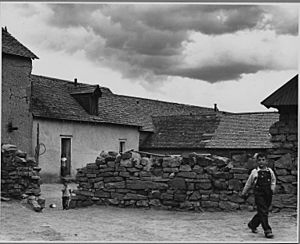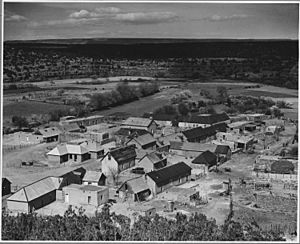El Cerrito, New Mexico facts for kids
Quick facts for kids
El Cerrito, New Mexico
|
|
|---|---|
|
Village
|
|

El Cerrito, San Miguel County, New Mexico. (1941)
|
|
| Country | United States |
| State | New Mexico |
| County | San Miguel |
| Elevation | 5,712 ft (1,741 m) |
| Population
(1990s)
|
|
| • Total | 25-30 |
| Time zone | UTC-7 (Mountain (MST)) |
| • Summer (DST) | UTC-6 (MDT) |
| GNIS feature ID | 915921 |
El Cerrito is a small village in San Miguel County, New Mexico, United States. It sits in the upper Pecos River valley. Settlers from a nearby town called Villanueva founded El Cerrito in 1824. Villanueva is about 5 miles (8 km) upstream. Most people living in El Cerrito are of Hispanic heritage.
This village has been studied a lot by experts since 1939. This is because it's quite isolated, far from big roads and cities. Its unique Hispanic culture also makes it special.
The Story of El Cerrito
Before 1786, Spanish settlements in New Mexico were mostly in the Rio Grande Valley. This was because of threats from Native American groups like the Comanches. After a peace treaty with the Comanches in 1786, it became safer to expand.
Spanish settlers began to move eastward towards the Great Plains. El Cerrito was one of the villages founded in the Pecos River Valley. It was part of the San Miguel del Vado Land Grant. This was a huge area of land, about 315,000 acres, given by the government. People received land if they agreed to live on the edge of the Spanish settlements.
The main reasons for settling the Pecos Valley were to give land to New Mexico's growing population. It also helped protect the Spanish and Pueblo Indian settlements in the Rio Grande valley. They needed protection from raids by Apache and other Native American groups.
Early Settlers and Life
People from nearby Villanueva (then called La Cuesta) settled El Cerrito between 1824 and 1827. El Cerrito was one of the closest New Mexican villages to the Great Plains. The Plains had large herds of bison and were home to Plains Indians.
Many Ciboleros, who were bison hunters, came from El Cerrito. Also, Comancheros, who traded with the Plains Indians, came from this village. These activities were important for the people living along the Pecos River.
In 1941, a U.S. government survey described El Cerrito. It said the village was in a "land pocket" along the Pecos River. This meant the valley widened just enough for a few houses and some farmland. The land was never big enough for full-time farming. However, it was vital for raising livestock and dry-land farming.
Families usually owned enough land for a garden and to grow food for a horse or two, a cow, and maybe a pig. The main way people earned money was from their livestock. These animals could roam freely on the surrounding mesa.
Changes Over Time
El Cerrito faced a big challenge in 1904. A U.S. court ruled that most of the land in the San Miguel del Vado Land Grant could no longer be owned by everyone together. This meant the people of El Cerrito ended up owning only about 118 acres of irrigated land and their house lots.
Over time, people from outside the village started buying the lands that used to be shared. This meant the villagers lost access to the grazing lands. These lands were the foundation of the village's economy.
Because of these changes, the population of El Cerrito dropped a lot. In 1940, there were 135 people living there. By the late 1960s, only five older adults remained. However, the population grew again. In 1992, there were nine households with 25 to 30 people living in the village full-time.



